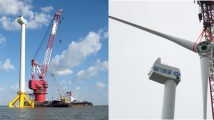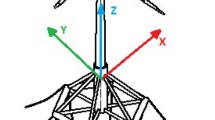Abstract
The asymmetric or periodically varying blade loads resulted by wind shear become more significant as the blade length is increased to capture more wind power. Additionally, compared with the onshore wind turbines, their offshore counterparts are subjected to additional wave loadings in addition to wind loadings within their lifetime. Therefore, vibration control and fatigue load mitigation are crucial for safe operation of large-scale offshore wind turbines. In view of this, a multi-body model of an offshore bottom-fixed wind turbine including a detailed drivetrain is established in this paper. Then, an individual pitch controller (IPC) is designed using disturbance accommodating control. State feedback is used to add damping in flexible modes of concern, and a state estimator is designed to predict unmeasured signals. Continued, a coupled aero-hydro-servo-elastic model is constructed. Based on this coupled model, the load reduction effect of IPC and the dynamic responses of the drivetrain are investigated. The results showed that the designed IPC can effectively reduce the structural loads of the wind turbine while stabilizing the turbine power output. Moreover, it is found that the drivetrain dynamic responses are improved under IPC.
Similar content being viewed by others
References
Balas, M.J., Lee, Y.J. and Kendall, L., 1998. Disturbance tracking control theory with application to horizontal axis wind turbines, Proceedings of 1998 ASME Wind Energy Symposium, AIAA, Reno, Nevada, pp. 12–15.
Bossanyi, E.A., 2003a. Individual blade pitch control for load reduction, Wind Energy, 6(2), 119–128.
Bossanyi, E.A., 2003b. GH Bladed Theory Manual, Garrad Hassan and Partners Limited, Bristol.
Bossanyi, E.A., 2005. Further load reductions with individual pitch control, Wind Energy, 8(4), 481–485.
Chen, C., Duffour, P. and Fromme, P., 2020. Modelling wind turbine tower-rotor interaction through an aerodynamic damping matrix, Journal of Sound and Vibration, 489, 115667.
Deutsche Institut für Normung eV, 1987. Tragfähigkeitsberechnung von Stirnrädern; Einführung und Allgemeine Einflußfaktoren, DIN 3990-1, Deutsche Institut für Normung eV, Berlin, Germany. (in German)
Ding, Q.W., Li, C., Cheng, S.S., Hao, W.X., Huang, Z.Q. and Yu, W., 2019. Study on TMD control on stability improvement of barge-supported floating offshore wind turbine based on the multi-island genetic algorithm, China Ocean Engineering, 33(3), 309–321.
Dunne, F., Pao, L.Y., Wright, A.D., Jonkman, B. and Kelley, N., 2011. Adding feedforward blade pitch control to standard feedback controllers for load mitigation in wind turbines, Mechatronics, 21(4), 682–690.
Ettefagh, M.M., 2015. Damage identification of a TLP floating wind turbine by meta-heuristic algorithms, China Ocean Engineering, 29(6), 891–902.
Fitzgerald, B., Sarkar, S. and Staino, A., 2018. Improved reliability of wind turbine towers with active tuned mass dampers (ATMDs), Journal of Sound and Vibration, 419, 103–122.
Hand, M.M., 2003. Mitigation of Wind Turbine/Vortex Interaction Using Disturbance Accommodating Control, National Renewable Energy Laboratory, Golden, CO, USA.
Helsen, J., Vanhollebeke, F., De Coninck, F., Vandepitte, D. and Desmet, W., 2011a. Insights in wind turbine drivetrain dynamics gathered by validating advanced models on a newly developed 13.2 MW dynamically controlled test-rig, Mechatronics, 21(4), 737–7521.
Helsen, J., Vanhollebeke, F., Marrant, B., Vandepitte, D. and Desmet, W., 2011b. Multibody modelling of varying complexity for modal behaviour analysis of wind turbine gearboxes, Renewable Energy, 36(11), 3098–3113.
Helsen, J., Vanhollebeke F., Vandepitte, D. and Desmet, W., 2010. Optimized inclusion of flexibility in wind turbine gearbox multibody model in view of model updating on dynamic test rig, Proceedings of the 1st International Conference on Multibody System Dynamics, Lirias, Lappeenranta, Finland, pp. 1–6.
Hussan, M., Sharmin, F. and Kim, D., 2017. Multiple tuned mass damper based vibration mitigation of offshore wind turbine considering soil-structure interaction, China Ocean Engineering, 31(4), 476–486.
International Electrotechnical Commission, 1999. Wind Turbine Generator Systems-Part 1: Safety Requirements, IEC 61400–1, second ed., IEC, Geneva.
Jonkman, B.J. and Buhl Jr, M.L., 2006. TurbSim User’s Guide, National Renewable Energy Laboratory(NREL), Golden, CO, USA.
Jonkman, J., Butterfield, S., Musial, W. and Scott, G., 2009. Definition of A 5-MW Reference Wind Turbine for Offshore System Development, National Renewable Energy Laboratory, Golden, CO, USA.
Jonkman, J.M. and Buhl Jr, M.L., 2005. FAST User’s Guide, National Renewable Energy Laboratory, Golden, CO, USA.
Kanev, S. and Van Engelen, T.G., 2009. Exploring the limits in individual pitch control, Proceedings of European Wind Energy Conference 2009, ECN, Marseille, France, pp. 1–12.
Kwakernaak, H. and Sivan, R., 1972. Linear Optimal Control Systems, John Wiley & Sons, Inc, New York.
Lackner, M.A. and Rotea, M.A., 2011. Structural control of floating wind turbines, Mechatronics, 21(4), 704–719.
Laks, J., Pao, L.Y., Wright, A., Kelley, N. and Jonkman, B., 2010. Blade pitch control with preview wind measurements, Proceedings of the 48th AIAA Aerospace Sciences Meeting Including the New Horizons Forum and Aerospace Exposition, AIAA, Orlando, FL.
Leithead, W.E., Neilson, V., Dominguez, S. and Dutka, A., 2009. A novel approach to structural load control using intelligent actuators, Proceedings of the 17th Mediterranean Conference on Control and Automation, IEEE, Thessaloniki, Greece, pp. 1257–1262.
Li, Y., Castro, A.M., Martin, J.E., Sinokrot, T., Prescott, W. and Carrica, P.M., 2017. Coupled computational fluid dynamics/multibody dynamics method for wind turbine aero-servo-elastic simulation including drivetrain dynamics, Renewable Energy, 101, 1037–1051.
Liew, J., Lio, W.H., Urbán, A.M., Holierhoek, J. and Kim, T., 2020. Active tip deflection control for wind turbines, Renewable Energy, 149, 445–454.
Lio, W.H., Galinos, C. and Urban, A.M., 2019. Analysis and design of gain-scheduling blade-pitch controllers for wind turbine down-regulation, Proceedings of the 2019 IEEE 15th International Conference on Control and Automation (ICCA), IEEE, Edinburgh, UK, pp. 708–712.
Lio, W.H., Jones, B.L., Lu, Q. and Rossiter, J.A., 2017. Fundamental performance similarities between individual pitch control strategies for wind turbines, International Journal of Control, 90(1), 37–52.
Lu, Q., Bowyer, R. and Jones, B.L., 2015. Analysis and design of Coleman transform-based individual pitch controllers for wind-turbine load reduction, Wind Energy, 18(8), 1451–1468.
Mandic, G., Nasiri, A., Muljadi, E. and Oyague F., 2012. Active torque control for gearbox load reduction in a variable-speed wind turbine, IEEE Transactions on Industry Applications, 48(6), 2424–2432.
Matsuishi, M. and Endo, T., 1968. Fatigue of metals subjected to varying stress, Japan Society of Mechanical Engineering, 96, 100–103.
Moriarty, P.J. and Hansen, A.C., 2005. AeroDyn Theory Manual, National Renewable Energy Laboratory, Golden, CO, USA.
Namik, H. and Stol, K., 2011. Performance analysis of individual blade pitch control of offshore wind turbines on two floating platforms, Mechatronics, 21(4), 691–703.
Nejad, A.R., Bachynski, E.E., Li, L. and Moan, T., 2016. Correlation between acceleration and drivetrain load effects for monopile offshore wind turbines, Energy Procedia, 94, 487–496.
Rezaei, M.M., Zohoor, H. and Haddadpour, H., 2018. Aeroelastic modeling and dynamic analysis of a wind turbine rotor by considering geometric nonlinearities, Journal of Sound and Vibration, 432, 653–679.
Roald, L., Jonkman, J., Robertson, A. and Chokani, N., 2013. The effect of second-order hydrodynamics on floating offshore wind turbines, Energy Procedia, 35, 253–264.
Shi, W., Park, H.C., Chung, C.W. and Kim, Y.C., 2011. Comparison of dynamic response of monopile, tripod and jacket foundation system for a 5-MW wind turbine, Proceedings of the Twenty-first International Offshore and Polar Engineering Conference, International Society of Offshore and Polar Engineers, Maui, Hawaii, USA.
Si, Y.L., Karimi, H.R. and Gao, H.J., 2014. Modelling and optimization of a passive structural control design for a spar-type floating wind turbine, Engineering Structures, 69, 168–182.
Simpack, A.G., 2018. SIMPACK Reference Guide-SIMPACK Release.
Tibaldi, C., Henriksen, L.C., Hansen, M.H. and Bak, C., 2014. Effects of gain-scheduling methods in a classical wind turbine controller on wind turbine aero-servo-elastic modes and loads, Proceedings of the 32nd ASME Wind Energy Symposium, AIAA, National Harbor, Maryland, pp. 1–12.
Wang, H., Hu, Z.Q. and Meng, X.Y., 2018. Dynamic performance investigation of a spar-type floating wind turbine under different sea conditions, China Ocean Engineering, 32(3), 256–265.
Wang, N., Johnson, K.E. and Wright, A.D., 2012. FX-RLS-based feedforward control for LIDAR-enabled wind turbine load mitigation, IEEE Transactions on Control Systems Technology, 20(5), 1212–1222.
Wright, A.D., 2004. Modern Control Design for Flexible Wind Turbines, National Renewable Energy Laboratory, Golden, CO, USA.
Wright, A.D. and Fingersh, L.J., 2008. Advanced Control Design for Wind Turbines; Part I: Control Design, Implementation and Initial Tests, National Renewable Energy Laboratory, Golden, CO, USA.
Xing, Y., Karimirad, M. and Moan, T., 2014. Modelling and analysis of floating spar-type wind turbine drivetrain, Wind Energy, 17(4), 565–587.
Xing, Y. and Moan, T., 2013. Multi-body modelling and analysis of a planet carrier in a wind turbine gearbox, Wind Energy, 16(7), 1067–1089.
Yin, X.X., LIN, Y.G., Li, W., Gu, Y.J., Wang, X.J. and Lei, P.F 2015. Design, modeling and implementation of a novel pitch angle control system for wind turbine, Renewable Energy, 81, 599–608.
Yuan, Y. and Tang, J., 2017. Adaptive pitch control of wind turbine for load mitigation under structural uncertainties, Renewable Energy, 105, 483–494.
Zhang, Y.Q., Chen, Z. and Cheng, M., 2013. Proportional resonant individual pitch control for mitigation of wind turbines loads, IET Renewable Power Generation, 7(3), 191–200.
Ziegler, L.S., 2015. Probabilistic Estimation of Fatigue Loads on Monopile-Based Offshore Wind Turbines, MSc. Thesis, Norwegian University of Science and Technology, Trondheim, Norwegian.
Funding
This paper is financially supported by the Scientific Research Foundation of Chongqing University of Technology (Grant Nos. 2020ZDZ023 and 2019ZD124), the Project of Science and Technology Research Program of Chongqing Education Commission of China (Grant No. KJQN202101133), and the National Natural Science Foundation Cultivation Program of Chongqing University of Technology (Grant No. 2021PYZ14).
Author information
Authors and Affiliations
Corresponding author
Rights and permissions
About this article
Cite this article
Xie, Sy., Zhang, Kf., He, J. et al. Modeling and Analyzing Dynamic Response for An Offshore Bottom-Fixed Wind Turbine with Individual Pitch Control. China Ocean Eng 36, 372–383 (2022). https://doi.org/10.1007/s13344-022-0033-8
Received:
Revised:
Accepted:
Published:
Issue Date:
DOI: https://doi.org/10.1007/s13344-022-0033-8




